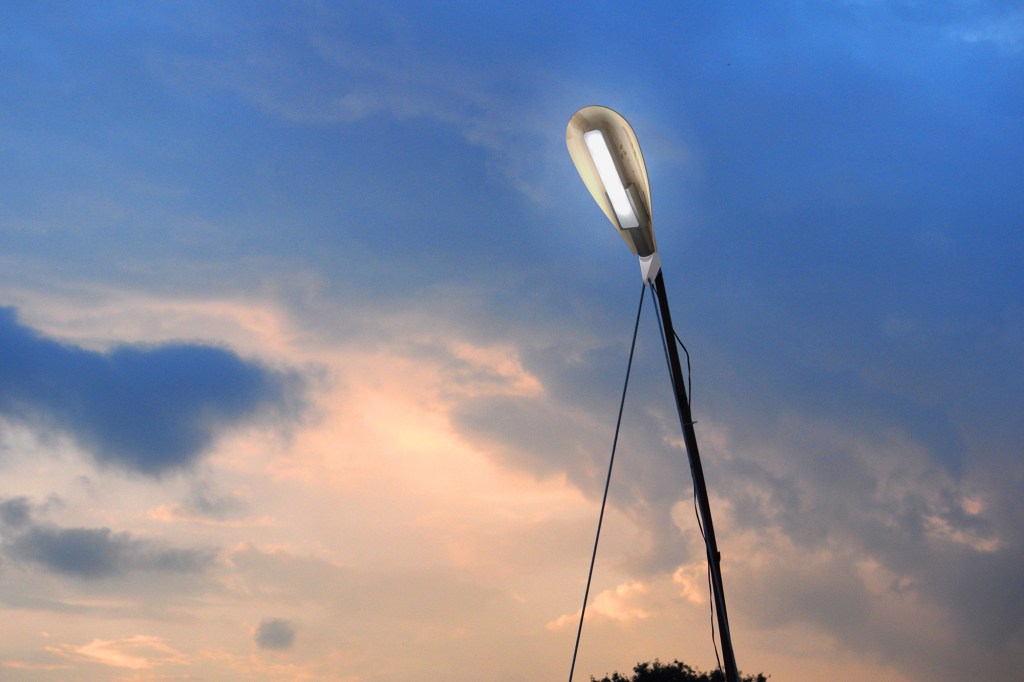“I really liked the combination of solving a modern problem in a context-appropriate way.” — juror Phillip Bernstein, FAIA
Among the many problems facing a rapidly growing, rapidly urbanizing country like India is infrastructure—in particular, how to provide public services to the tens of millions of people who live in slums on the sprawling outskirts of large cities.

Kennedy & Violich Architecture
Part of the problem is that conventional solutions to things like public lighting are top-down and expensive, because they rely on buying imports and need to be installed as part of a larger network. “We have a lot of systems that are extremely centralized,” says Huda Jaffer, lead designer at the SELCO Foundation, a not-for-profit “social enterprise” that aims to bring sustainable electricity to India’s poor.

In designing a portable, locally manufacturable street lamp, SELCO, which partnered with Boston-based Kennedy & Violich Architecture (KVA), decided the only answer was to go greener. “We’re trying to become sustainable not just on the operating energy side of things, but on the embodied energy side as well,” says Sheila Kennedy, FAIA, a founding principal of KVA. The carbon-zero Re: Lamp is built around a bamboo mast, which is plentiful and can be harvested locally. Fixtures and hardware—like the battery box, LED head, and tension cables—come in a kit of parts distributed from urban centers; other components, like the LED mount, can be made locally on a 3D printer. Shades are produced by area manufacturers that make dishware from the fibers of areca palm trees, using the same manufacturing process, just with a digitally fabricated mold. When the pieces are assembled, the result is a lamp that one can buy and build for next to nothing—and that uses 250 percent less embodied energy than a steel equivalent. And it’s just as strong, if not more so, says KVA designer Robert White. “The locally sourced bamboo was like a supermaterial,” he says. “If I had asked for carbon fiber, I couldn’t have gotten a better material.”

Kennedy & Violich Architecture
But it’s not just the environment that benefits. By decentralizing the construction and ownership of the lamps, the project encourages “streetlight entrepreneurs” to rent their products and services—say, to nighttime sports or education events. “There are lots of skilled artisans in India who are getting a dollar a day,” Jaffer says. “We asked, ‘How can we push a product that draws on these skills as well?’ ”

jvarholick
With lighting entrepreneurs in a village or neighborhood, suddenly it doesn’t matter whether the locals are “on the grid.” They can hire a light owner to come set up shop by their evening school or night market. And if parts break, they’re easily replaceable.
Kennedy calls such high-tech/low-tech innovation “hybridization,” and she says she sees more and more of it in the developing world. These approaches are going to be absolutely critical in future efforts to integrate developing countries into the rest of the world.

Kennedy & Violich Architecture


Kennedy & Violich Architecture

Project Credits
Project: Re:LAMP
Client: SELCO Foundation
Design Firm: Kennedy & Violich Architecture, Boston . Sheila Kennedy, FAIA (principal, project adviser); Robert White (designer, primary investigator) Project Team: SELCO Foundation, Bangalore, India . Huda Jaffer (lead designer), Varsha Sastry (product designer), Assad Jaffer (fabrication partner)
Research Assistants: MIT, Cambridge, Mass. . Joe Varholick, Charlotte D’Acierno, Danniely Staback, Anne Graziano, Ching Ying Ngan, Alice Kao
Fabricator: SELCO Foundation
Funding: The Lemelson Foundation
Special Thanks: Santhi Davedu (senior program manager at SELCO Foundation); Khyati Shukla (product designer at SELCO Foundation); Ujire Areca Manufacturer









